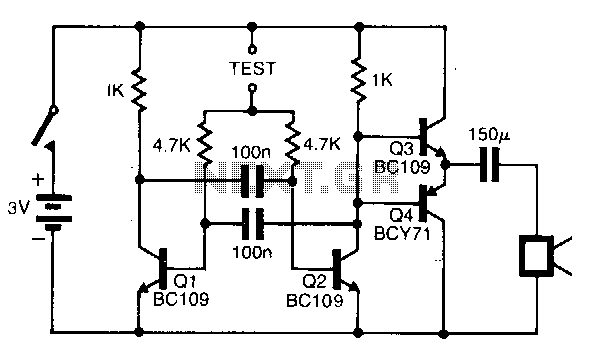
Continuity-tester

The continuity tester supplies a voltage through the positive probe to the circuit being tested, while the negative probe acts as the return line. The voltage that returns to the tester via the negative probe activates the circuit, providing an audible indication of continuity.
A continuity tester is a simple yet essential tool in electronics that verifies whether a circuit is complete, allowing current to flow. The device typically consists of a battery, two probes (positive and negative), and an audible indicator such as a buzzer or speaker.
When the positive probe is connected to one part of the circuit and the negative probe is connected to another, the tester applies a small voltage across the circuit. If the circuit is intact, the voltage travels through the conductive path, returning to the tester through the negative probe. This return voltage is detected by the tester's internal circuitry, which activates the audible signal, indicating continuity.
The design of a continuity tester can vary, but it often includes a resistor to limit the current and protect sensitive components. Additionally, some continuity testers may incorporate a diode to prevent reverse polarity connections, ensuring the device operates safely and effectively.
For enhanced functionality, certain continuity testers may also feature a visual indicator, such as an LED, which lights up in conjunction with the audible alert. This dual indication can be particularly useful in noisy environments where the sound may not be easily heard.
Overall, a continuity tester is a vital instrument for troubleshooting and verifying electrical connections in various applications, from simple household wiring to complex electronic circuits.The continuity tester feeds a voltage through the positive probe to the circuit-under-test, while the negative probe serves as the return line. Voltage that returns to the tester through the negative probe triggers the circuit, giving an audible indica tion of continuity. 🔗 External reference
A continuity tester is a simple yet essential tool in electronics that verifies whether a circuit is complete, allowing current to flow. The device typically consists of a battery, two probes (positive and negative), and an audible indicator such as a buzzer or speaker.
When the positive probe is connected to one part of the circuit and the negative probe is connected to another, the tester applies a small voltage across the circuit. If the circuit is intact, the voltage travels through the conductive path, returning to the tester through the negative probe. This return voltage is detected by the tester's internal circuitry, which activates the audible signal, indicating continuity.
The design of a continuity tester can vary, but it often includes a resistor to limit the current and protect sensitive components. Additionally, some continuity testers may incorporate a diode to prevent reverse polarity connections, ensuring the device operates safely and effectively.
For enhanced functionality, certain continuity testers may also feature a visual indicator, such as an LED, which lights up in conjunction with the audible alert. This dual indication can be particularly useful in noisy environments where the sound may not be easily heard.
Overall, a continuity tester is a vital instrument for troubleshooting and verifying electrical connections in various applications, from simple household wiring to complex electronic circuits.The continuity tester feeds a voltage through the positive probe to the circuit-under-test, while the negative probe serves as the return line. Voltage that returns to the tester through the negative probe triggers the circuit, giving an audible indica tion of continuity. 🔗 External reference
Warning: include(partials/cookie-banner.php): Failed to open stream: Permission denied in /var/www/html/nextgr/view-circuit.php on line 713
Warning: include(): Failed opening 'partials/cookie-banner.php' for inclusion (include_path='.:/usr/share/php') in /var/www/html/nextgr/view-circuit.php on line 713
